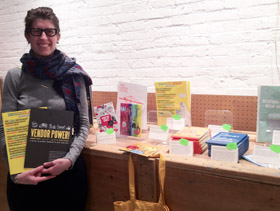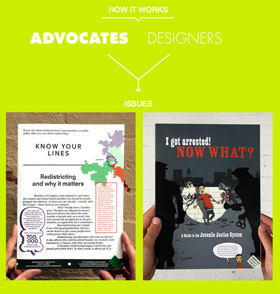IAP Externships: Making Public Policy Accessible
-
-
slice.mit.edu
Filed Under
Recommended
Guest blogger: Mariel Villeré, grad student pursuing a master of science in architecture studies, focusing on the history, theory, and criticism of architecture and art Host: Christine Gaspar MA '04, MCP '04

Approaching the old American Can Factory in Brooklyn on a cold January morning, the wind pushed me along the sidewalks through the barren industrial landscape to my first day at the Center for Urban Pedagogy (CUP). I have admired the work of the organization for several years and finally had the opportunity to connect with them directly via my externship sponsor, Christine Gaspar.
CUP works to make public policy accessible, directing and coordinating designers and advocacy groups to address issues that demand public attention but lack transparency. Visualization tools such as graphic novels, bold charts, and video animations equip community organizations with the tools for citizen empowerment.
One of the most prevalent avenues for distributing this information is, of course, their website. In fact, their new website launched on my first day of the externship. Reviewing the site and its breadth of content better introduced me to their work and prepared me for the outreach and distribution efforts I would be undertaking.

The Making Policy Public (MPP) project is a series of pamphlets produced through the aforementioned partnerships on topics ranging from predatory equity, street vendors’ rights, the cargo network of industrial shipping and trading, getting a job after serving time, and, for teens, how to navigate being arrested. One of my first tasks was to follow up with community groups distributing these pamphlets to gather information about how they’ve been used, who has been using them, and how to make these sorts of projects more useful in the future. It was fascinating to get perspectives from tenants' rights organizations, the Midtown community court, and others as to whose hands these pamphlets have been in and what effects they’ve had on individual lives.
I have been working on developing relationships with independent and museum bookshops throughout the five boroughs of New York to start selling the MPPs on their shelves. It has been interesting to revisit some of my favorite neighborhood booksellers in a business capacity, connecting with them through CUP and the appeal for their clientele. This has been especially practical experience for my anticipated future work in publications, particularly low-volume, creative publications.
The energy behind CUP is inspiring, and the office environment is like no other I’ve experienced—open, light, and collaborative. I appreciate the creative connections CUP makes to generate new perspectives and educational tools for their partners and constituents. It’s also been fun to explore Gowanus, a neighborhood I only vaguely knew prior to this month, and to reconnect with other parts of New York that I’ve felt nostalgic for.
The best part about this experience has been an immediate shift in the lens through which I see urban spaces. I notice new layers that CUP addresses in its work and feel strongly about political (both local and national) decisions that may seem arbitrary, but can have a major effect on daily urban life. I am excited to continue these projects over the next two weeks and hope to find myself continually tuning in to new planning and policy measures.






